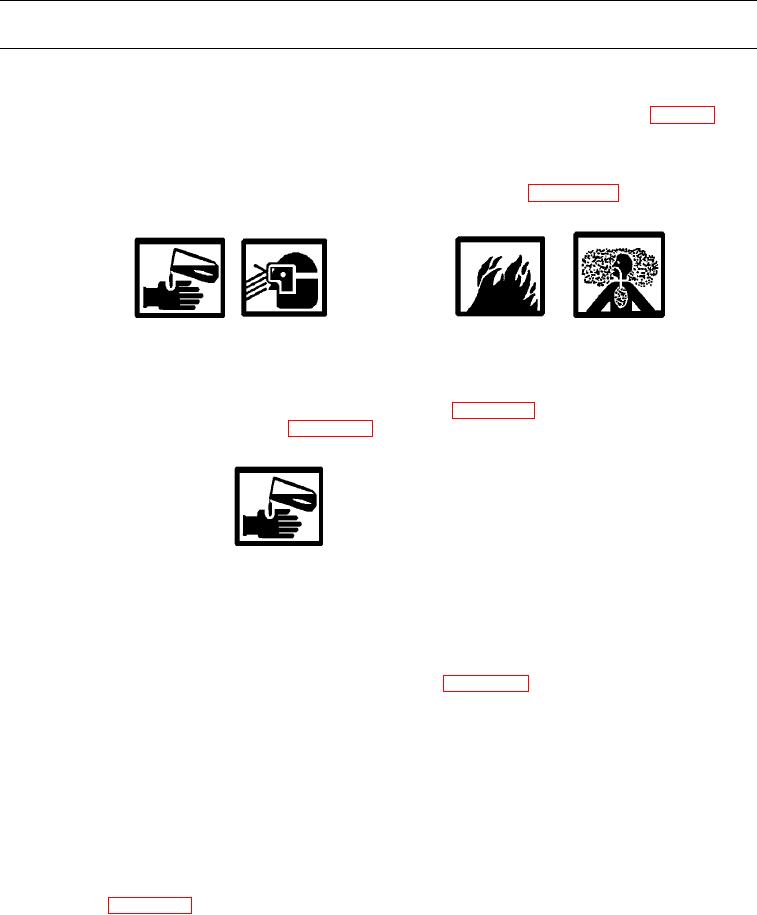
TM 5-3805-291-23-1
PREVENTIVE MAINTENANCE CHECKS AND SERVICES
(PMCS) INTRODUCTION - CONTINUED
0019 00
GENERAL PMCS PROCEDURES
1.
Always perform PMCS in the same order so it gets to be a habit. Once you have had some practice, you will spot any-
thing wrong in a hurry. If any deficiency is discovered, perform the appropriate troubleshooting task in Chapter 2 of this
manual. If any component or system is not serviceable or if the given service does not correct the deficiency, notify your
supervisor.
2.
Before performing preventive maintenance, read all the checks required for the applicable interval and prepare every-
thing needed to make all the checks. Have several clean Rag, wiping (Item 35, WP 0233 00) handy. Perform ALL
inspections at the applicable interval.
WARN I N G
Solvent cleaning compound MIL-PRF-680 Type III is an environmentally compliant and low toxic mate-
rial. However, it may be irritating to the eyes and skin. Use protective gloves and goggles. Use in well-venti-
lated areas. Keep away from open flames and other sources of ignition.
a.
Keep It Clean. Dirt, grease, oil, and debris get in the way and may cover up a serious problem. Clean as you work
and as needed. Use Cleaning compound, solvent, type III (Item 7, WP 0233 00) on all metal surfaces. Use Deter-
gent, general purpose, liquid (Item 9, WP 0233 00), and water when you clean rubber, plastic, and painted sur-
faces.
WARN I N G
When servicing this machine, performing maintenance or disposing of materials such as engine coolant,
hydraulic fluid, lubricants, battery acids or batteries, windshield cleaning compound, and CARC paint,
consult your unit/local hazardous waste disposal center or safety office for local regulatory guidance. If fur-
ther information is needed, please contact The Army Environmental Hotline at 1-800-872-3845.
b.
Hazardous Waste Disposal. Ensure all spills are cleaned up and disposed of IAW local policy and ordinances.
c.
Rust and Corrosion. Check metal parts for rust and corrosion. If any bare metal or corrosion exists, clean and
apply a light coat of Oil, lubricating, OEA-30, Arctic (Item 29, WP 0233 00). Report it to your supervisor.
d.
Bolts, Nuts, and Screws. Check bolts, nuts, and screws for obvious looseness, missing, bent, or broken condition.
You cannot try them all with a tool, but look for chipped paint, bare metal, or rust around bolt heads. If you find
one is loose, tighten it.
e.
Welds. Look for loose or chipped paint, rust, or gaps where parts are welded together. If you find a bad weld,
report it to your supervisor.
f.
Electric Wires and Connectors. Look for cracked or broken insulation, bare wires, and loose or broken connec-
tors. Reconnect loose connectors. Ensure wires are in good condition.
g.
Hoses and Fluid Lines. Look for wear, damage, and signs of leaks. Check for loose clamps and fittings. Wet spots
indicate leaks, but a stain around a fitting or connector can also mean a leak. If a leak comes from a loose fitting or
connector, tighten it. If something is broken or worn out, correct it if authorized by the Maintenance Allocation
Chart (WP 0232 00). If not authorized, notify your supervisor.
h.
Fluid Leakage. It is necessary for you to know how fluid leakage affects the status of your machine. The follow-
ing are definitions of the types/classes of leakage you need to know to be able to determine the status of your
machine. Learn and be familiar with them and remember: when in doubt, notify your supervisor.
0019 00-2

